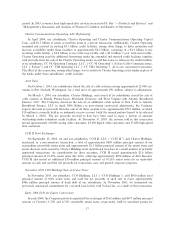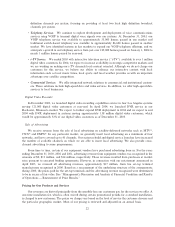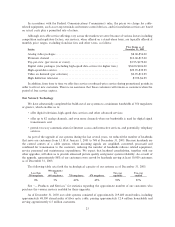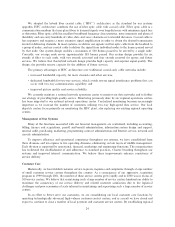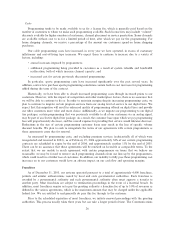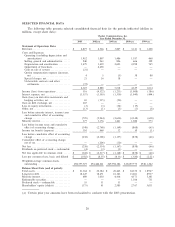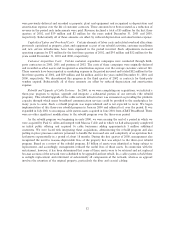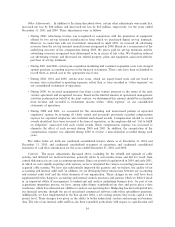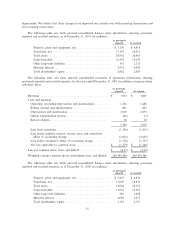Charter 2003 Annual Report Download - page 28
Download and view the complete annual report
Please find page 28 of the 2003 Charter annual report below. You can navigate through the pages in the report by either clicking on the pages listed below, or by using the keyword search tool below to find specific information within the annual report.Costs
Programming tends to be made available to us for a license fee, which is generally paid based on the
number of customers to whom we make such programming available. Such license fees may include ""volume''
discounts available for higher numbers of customers, channel placement or service penetration. Some channels
are available without cost to us for a limited period of time, after which we pay for the programming. For
home shopping channels, we receive a percentage of the amount our customers spend on home shopping
purchases.
Our cable programming costs have increased, in every year we have operated, in excess of customary
inÖationary and cost-of-living type increases. We expect them to continue to increase due to a variety of
factors, including:
‚ annual increases imposed by programmers;
‚ additional programming being provided to customers as a result of system rebuilds and bandwidth
reallocation, both of which increase channel capacity; and
‚ increased cost for certain previously discounted programming.
In particular, sports programming costs have increased signiÑcantly over the past several years. In
addition, contracts to purchase sports programming sometimes contain built-in cost increases for programming
added during the term of the contract.
Historically, we have been able to absorb increased programming costs through increased prices to our
customers. However, with the impact of competition and other marketplace factors, there is no assurance that
we will be able to continue to do so. In order to maintain margins despite increasing programming costs, we
plan to continue to migrate certain program services from our analog level of service to our digital tiers. We
expect that this migration will result in enhanced quality of programming oÅered on digital tiers and provide
our video customers more value and more choice. Additionally, as we migrate our programming to our digital
tier packages, certain programming that was previously available to all of our customers via an analog signal,
may be part of an elective digital tier package. As a result, the customer base upon which we pay programming
fees will proportionately decrease, and the overall expense for providing that service would likewise decrease.
Reductions in the size of certain programming customer bases may result in the loss of speciÑc volume
discount beneÑts. We plan to seek to renegotiate the terms of our agreements with certain programmers as
these agreements come due for renewal.
As measured by programming costs, and excluding premium services (substantially all of which were
renegotiated and renewed in 2003), as of February 19, 2004 approximately 34% of our current programming
contracts are scheduled to expire by the end of 2004, and approximately another 11% by the end of 2005.
There can be no assurance that these agreements will be renewed on favorable or comparable terms. To the
extent that we are unable to reach agreement with certain programmers on terms that we believe are
reasonable, we may be forced to remove such programming channels from our line-up by the programmers,
which could result in a further loss of customers. In addition, our inability to fully pass these programming cost
increases on to our customers would have an adverse impact on our cash Öow and operating margins.
Franchises
As of December 31, 2003, our systems operated pursuant to a total of approximately 4,400 franchises,
permits and similar authorizations issued by local and state governmental authorities. Each franchise is
awarded by a governmental authority and such governmental authority often must approve a transfer to
another party. Most franchises are subject to termination proceedings in the event of a material breach. In
addition, most franchises require us to pay the granting authority a franchise fee of up to 5.0% of revenues as
deÑned in the various agreements, which is the maximum amount that may be charged under the applicable
federal law. We are entitled to and generally do pass this fee through to the customer.
Prior to the scheduled expiration of most franchises, we initiate renewal proceedings with the granting
authorities. This process usually takes three years but can take a longer period of time. The Communications
26



